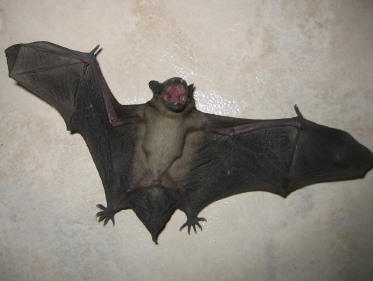(10/18) Bats are especially popular at Halloween, and with that time fast approaching, we will see lots of bats in black as one of the scary symbols of the season. Bats are the only mammals that fly, and one of the only mammals known to feed on blood, hence the bat’s reputation for being scary, and especially at Halloween!
Realistically, bats are not scary at all and are real contributors to the well-being of our ecosystem. Common misconceptions and fears about bats have led many to regard them as unclean disease carriers, when they are actually very helpful in controlling the population of crop-destroying insects. World-wide, there are more than 900 species of bats,
making up one-fifth of the mammal population on Earth. (Source: Bat Conservation International.)
Bats play an important role in many environments around the world; over 500 plant species rely on bats to pollinate their flowers, especially certain species of mango, banana, cocoa, guava and agave (used to make tequila.) The next time you eat chocolate or have a margarita, say thanks to bats! The bat’s pollinator role in the US is key to numerous
species of cactus in the Southwest. This role of the bat as a pollinator of plants in general is known as chiropterophily.
Some bats are an "indicator species", because changes to these bat populations can indicate changes in important aspects of biodiversity. Bats suffer when there are problems with insect populations or when habitats are destroyed, as some bats of the world live in large woodlands. So you see, as evidenced by the commentary above, bats are not really
so scary and are much more than a symbol of Halloween!
 Bats are divided into two types – megabats and microbats. Megabats include Flying Foxes and Old World fruit bats. They tend to be larger than microbats, but some microbats are actually bigger. The Flying Fox bat can have a wingspan of 5 to 6 feet. The smallest megabat has a wingspan of 10
inches and weighs half an ounce. By comparison, the largest microbat is the False Vampire with a wingspan of 40 inches. The smallest microbat is the Bumblebee bat – 1 ¼ inches long and 2 grams (.07 ounces).
Bats are divided into two types – megabats and microbats. Megabats include Flying Foxes and Old World fruit bats. They tend to be larger than microbats, but some microbats are actually bigger. The Flying Fox bat can have a wingspan of 5 to 6 feet. The smallest megabat has a wingspan of 10
inches and weighs half an ounce. By comparison, the largest microbat is the False Vampire with a wingspan of 40 inches. The smallest microbat is the Bumblebee bat – 1 ¼ inches long and 2 grams (.07 ounces).
Bats live all over the world. The exception is some remote islands, the Arctic and Antarctica. Bats prefer warmer areas close to the equator, and can be found in rain forests, mountains, farmland, woods and cities. Those bats that are able to tolerate cold weather either migrate to warmer areas when temperatures plummet, or go into "torpor". Torpor
is a form of hibernation - a bat reduces its metabolic rate, lowers its body temperature, and slows its breathing and heart rate.
Bats roost in trees, caves, mines and barns – anyplace that provides shelter from weather and protection from predators. They live together in colonies and are nocturnal. Bats can fly up to 30 miles in a night to find food. During the day, they sleep upside down, holding onto grooves or ledges with their sharp claws.
Their mating habits are unique – they meet in hibernation sites, swarm in large numbers and perform "spectacular aerobatics". It is not clear how they choose a mate, but breeding pairs go off to secluded spots, away from the swarm, to mate. The female gives birth to one pup that drinks milk from its mother, much like other mammals. The mothers and
pups stay in groups, separate from males. Other mothers help take care of the pup until it is old enough to survive on its own.
What is important to note from the above information is that bats are surely much more than a symbol of Halloween. They are an important contributor to major ecosystems in our world. And, like many contributors important to the reproductive cycle of our food sources, the bat species is threatened with extinction. I mentioned earlier that there are
more than 900 species of bats. According to the Red List from the International Union for Conservation of Nature, more than 250 species of bats are endangered. A fungus that causes white-nose syndrome has devastated bats in North America. This powdery-looking fungus coats the muzzles, ears and wings of bats and has meant death for hundreds of thousands of these animals in
the Northeastern United States.
So in the spring when the local bat population becomes active, look for them and be glad they are thriving in your environment! When a bat swoops toward you on a warm summer’s evening, know that it might just be saving you from a mosquito bite that very night. When you next enjoy a piece of chocolate, know that a bat probably pollinated that cacao
plant in some tropical climate to make it possible. And when you see large, 2-legged bat-like creature along with ghosts and goblins this Halloween, run and hide, just like the rest of us!
Read other articles on birds, wildlife & beneficial insects
Read other articles by Kay Hinkle